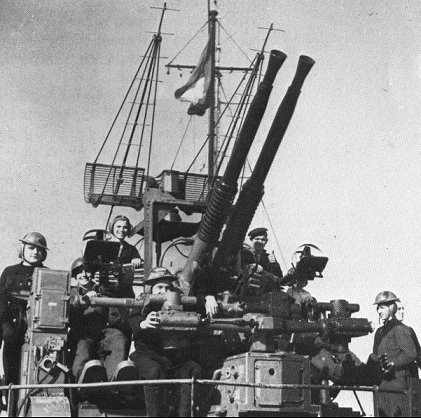![]()
Bofors 40 mm L/60 No.3 and 4
![]()
The Bofors 40 mm and its use in the Royal Netherlands Navy is an excellent example of technical innovation before World War II. The Swedish Bofors factories developed an excellent mid-range AA-weapon, using the experience of Krupp with semi-autmatic guns. A high rate of fire and a relative good "punch" were the key features of this type. The navy developed a system for triaxially stabilizing these guns, which meant that for example the impact of the sea state on fire control accuracy was reduced. Five twin mounts for De Ruyter were ordered in July 1933, followed by another order for 24 twins in 1939. Later, when Dutch naval researchers developed a new version of radar suited for short range AA-control, a combination between the radar and the gun was proposed just before the war, but the German invasion prevented further testing. Fortunately, two radarsets (type 289 "of Dutch origin") were transported at the very last moment to England, where they were mounted on the destroyer Isaac Sweers, at that time still at the dockyard. The Royal Navy was so under the impression of this gun, that they ordered 200 modified sets with Vickers-Armstrong using the Type 282 radar. This order was later followed by many more. Via the embassy in America, the US Navy also acquired the drawings and altered them to meet their own needs. Later, they were used in large numbers on almost every type of ship during the war in a large number of variations. Some types are still in service today.
Before the war, the Dutch had two types in service, the No.3 and No.4. The first version (used on the cruisers Java and De Ruyter) had a central fire control system, the latter had fire control for individual mounts.
 |
| Mount on Isaac Sweers. Note the radar aerials. |
| Gun specs | ||
| Gun type | Bofors 40 mm No.3 and 4. | |
| Use | No.3: cruisers Java and De Ruyter No.4: various ships, a.o. flotillaleader Tromp |
|
| Purpose | Medium anti-aircraft defence | |
| Bore | 40 mm | |
| Gun length | 60 calibres | |
| Cooling | Aircooled | |
| Gunweight | ?? kg | |
| Initial velocity | 880 metres/second | |
| Rate of fire | 120 rounds/min | |
| Range | 2500 metres @ max. elevation (effective) 7000 metres @ max. elevation (max/vertical) 10000 m @ 0 degrees (max/horizontal) |
|
| Shell specs | ||
| Shell types | High Explosive | |
| Shell weight | 0.9 kg | |
| Propellant charge | 0,3 kg | |
| Mount specs | ||
| Elevation | +90/-15 degrees | |
| Train | 360 degrees | |
| Weight | 5500 kg | |
| Train method | Manual | |
![]()
Sources
J. Anten et al "Hr.Ms. Kruisers 'Java' and 'Sumatra'"
![]()
Back
Home